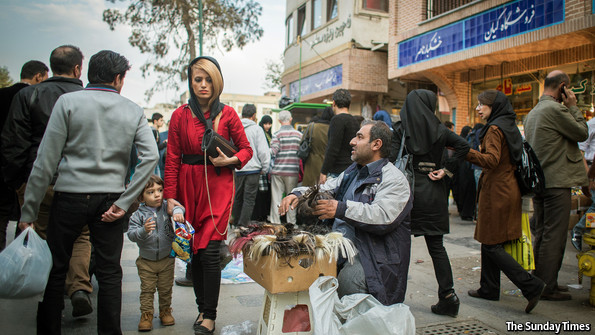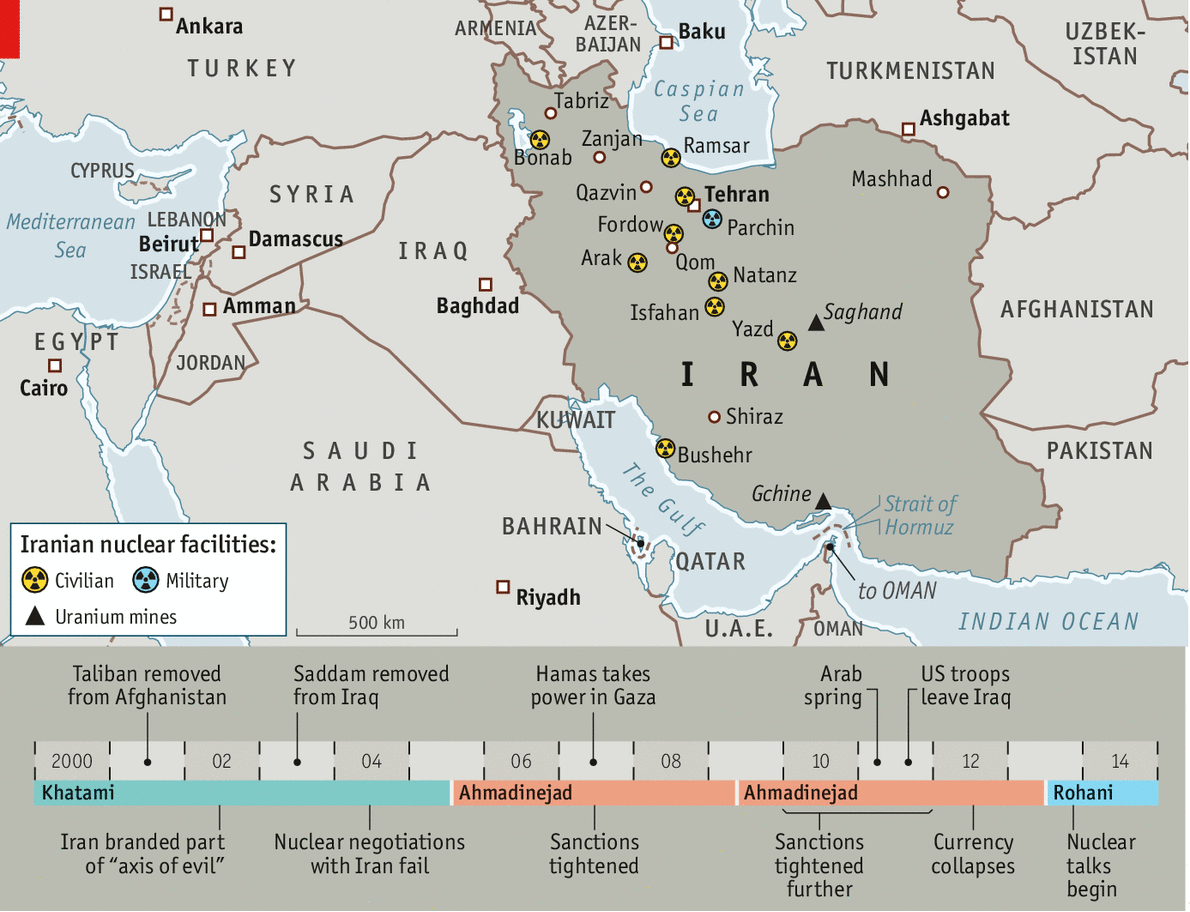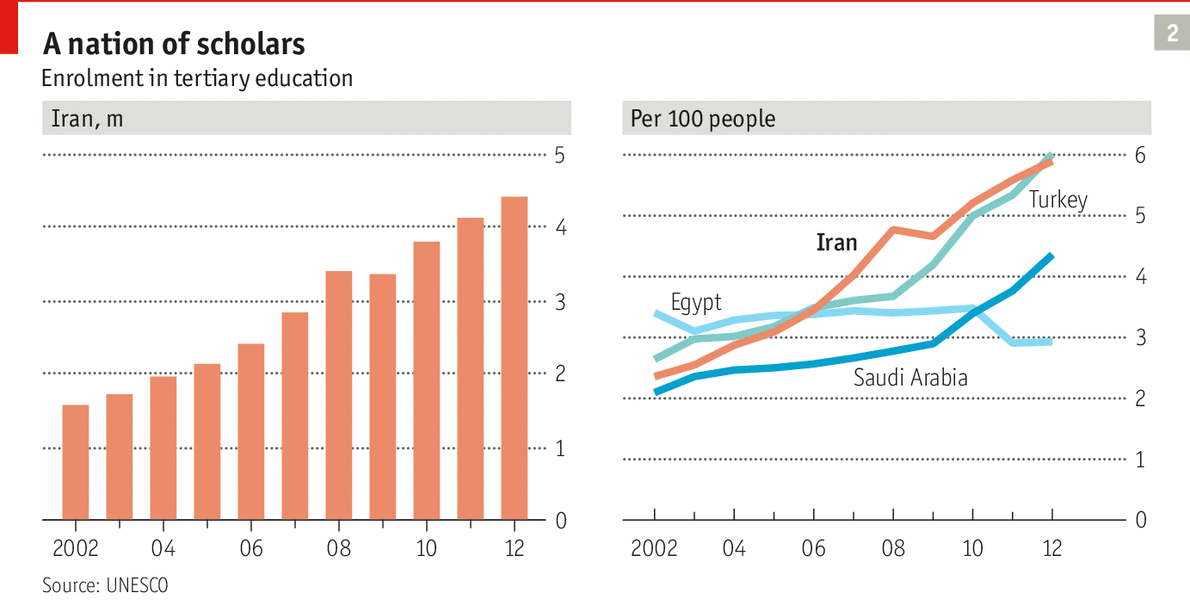The revolution is over
After decades of messianic fervour, Iran is becoming a more mature and modern country, says Oliver August

FROM THE MOUNTAINS of the Caucasus to the waters of the Indian Ocean, Iranians are watching intently as their government haggles with foreign powers over trade sanctions imposed to restrain its nuclear programme. Pointing to a corner of his office, the owner of a struggling cannery says: “See that television set? I watch it hour by hour, hoping for news that sanctions will be lifted.”
Iran says its nuclear programme is for peaceful purposes only. The West, not unreasonably, fears that Iran is building a bomb. In the hope of preventing a nuclear arms race in the Middle East, America and its allies have made it very difficult for Iran to engage in international commerce. The country’s oil exports have dwindled to half their former level. The Iranian government, for its part, has broken a habit of a lifetime and publicly held detailed discussions with countries it regards as hostile, including America. As this special report will explain, its motives are internal as much as external. All sides are keen to find a solution to this long-running stand-off. A deadline of November 24th has been set. An agreement to shackle the nuclear programme would have wide-ranging geopolitical consequences and could push Iran further towards modernity.
For now, Iran is disliked and mistrusted across much of the democratic world. Terrible things have been done in the name of its revolution. Some of its leaders have denied the Holocaust. They have locked up and tortured citizens who dared to challenge them openly. The country really could be set on having a bomb. But while the world has been cut off from Iran, it has failed to notice how much Iranians have changed. No longer is the country seething with hatred and bent on destruction. Instead, the revolution has sunk into the disillusion and distractions of middle age. This is not always a nice place, perhaps, but not a Satanic one, either.
To be sure, Iran is hard to fathom. It often makes visitors feel unwelcome. Journalists who have been able to obtain a precious visa still leave with a sense of uncertainty as few Iranians feel free to speak their mind. For years the government even refused to share information with the World Bank. John Limbert, an American diplomat held hostage in Tehran in 1979 who served his country until 2010, points out that “almost nobody in Washington has been to Iran in decades.”
Yet the country has unmistakably changed. The regime may remain suspicious of the West, and drone on about seeding revolutions in oppressor countries, but the revolutionary fervour and drab conformism have gone. Iran is desperate to trade with whomever will buy its oil. Globalisation trumps puritanism even here.
Revolution as a political lodestar has a limited shelf life. Adam Michnik, a historian who helped to overthrow the Soviets in Poland, once said: “Revolutions have two phases: first comes a struggle for freedom, then a struggle for power. The first makes the human spirit soar and brings out the best in people. The second unleashes the worst: envy, intrigue, greed, suspicion and the urge for revenge.” Iran followed this pattern. First came courageous street protests during the 1979 revolution, then the infighting started. Thousands were executed, properties were seized, bread was short.

Colour me mellow
Arguably, there is a third phase to a revolution: the struggle for acceptance. Once power is secure, revolutionaries often seek recognition by strong outsiders. In a globalised world, that means engaging with the great trading countries. Children of Iranian revolutionaries have long followed this path. Privilege for them equals access to Western education and Asian consumer markets. Even hardliners allow their children to jet around the world. The offspring of Ayatollah Ruhollah Khomeini, who led the revolution, have flocked to Instagram and embrace Western mores. Seven of his 15 grandchildren have openly criticised the regime. Many of the students who took American diplomats hostage 35 years ago have become reformists and wish to see closer ties with the West. Ebrahim Asgharzadeh, who was one of their spokesmen and then served on Tehran’s city council, now says: “I no longer take radical actions and I believe gradual reforms last longer than radical change.”
The appetite for revolution has waned on all sides. Reformists are tired after their failed attempt in 2009 to push aside a government they considered illegitimate because the vote was rigged. Protests were put down bloodily, reminding many of the unhappy years after the revolution. Since then, reformists have recoiled at political bloodshed in neighbouring countries. Conservatives, for their part, have come to see revolution as a threat to their interests abroad; regimes they fostered in Iraq and Syria are fighting rebellions not unlike Iran’s home-grown one in 1979. “The Arab spring fallout has scared everyone,” says a Western diplomat in Tehran. “Iran is now a bastion of stability. The question of the validity of the regime has been settled.”
Many regard the nuclear programme as a symbol of national strength at a time of perplexing social changes
Yet although revolutionary fervour has waned, Iran’s 1979 revolution itself remains a source of legitimacy for the regime. Many Iranians, or at least the ethnic Persian majority among them, continue to associate it with national liberation from foreign oppression. Not being Arab, Turkic or South Asian, they feel friendless among their neighbours. This is vital to understanding Iranian foreign policy and helps explain why the nuclear programme enjoys widespread popular support despite the pain that the sanctions have inflicted. Many regard it as a symbol of national strength at a time of perplexing social changes. This special report will examine the effect of those changes on Iran’s politics, its economy and its place in the world.
Hardliners have long railed against “Westoxification” (the title of a book by Jalal Al-e Ahmad, published in 1962), yet in their daily lives they are now surrounded by Western consumer goods, computer games, beauty ideals, gender roles and many other influences. Iranian culture has not disappeared, but the traditional society envisaged by the fathers of the revolution is receding ever further.
The most visible shift is in public infrastructure. Tehran, the capital, is a tangle of new tunnels, bridges, overpasses, elevated roads and pedestrian walkways. Shiny towers rise in large numbers, despite the sanctions. Screens at bus stops display schedules in real time. Jack Straw, a former British foreign minister and a regular visitor, says that “Tehran looks and feels these days more like Madrid and Athens than Mumbai or Cairo.”
Smaller Iranian cities have changed even more. Tabriz, Shiraz and Isfahan are working on underground railways. Half the traditional bathhouses in Qazvin, an industrial town west of Tehran, have closed in recent years. In a basement with a domed ceiling built 350 years ago, the forlorn manager sweeps around two kittens and bemoans the loss of a 700-year-old competitor, musing that “people now have bathrooms with hot running water.” In Yalayesh, a remote village near the Caspian sea, entertainment remains old-fashioned: a Kurdish strongman, Ismail the Hero, shows off a lion in a cage on the back of his blue truck. Still, two years ago the government finished piping natural gas into every house, making winters with temperatures of -20ºC “tolerable for the first time”, says a spectator.
During the eight-year presidency of Mahmoud Ahmadinejad, which ended in 2013, prosperity spread rapidly. Loans, handouts and social-housing programmes, however corrupt and ineptly run, showered billions of oil dollars on the poor. Many found white-collar jobs in government agencies. The middle class ballooned. Villagers streamed into Tehran to buy property as GDP per person rose from $4,400 in 1993 to $13,200 last year (at purchasing-power parity). Despite the sanctions, Iran does not look like beleaguered Cuba; people drive new sedans made locally, not 1950s Chevrolets. Life became harder when sanctions were tightened in 2011, but even now Iranians live much better than most of their neighbours.
Prosperity has inspired an obsession with technology that restrictions on internet access cannot dampen. Facebook is the primary medium for half the country’s youth and Twitter is used by officials to put out statements—never mind that both are banned. Freedom House, an American human-rights lobby, ranks Iran last in the world in terms of internet freedom, but in reality access is cheap and fast. (The fastest speeds are achieved near seminaries, since clerics preach online and get priority on fibre-optic cables.)
Although the media are controlled by the state, uncensored news is easily available. Foreign websites like Tehran Bureau, based in London, fill the gaps. Iranians access them using virtual private networks (VPN). Almost everybody has one. Sitting under a tree in the Alborz mountains, a group of farmers nod cautiously when asked about internet access. One of them explains later that most download “sexy films”, hence the shy response. Pornography, although strictly banned, blazes a trail for freedom.
“The government tries to put up controls, but people are well versed in evading them,” says one of Iran’s first bloggers. A lot of effort has gone into trying to mimic China’s strategy of nurturing local websites that can be controlled, such as salam.ir, a search engine. But most of these have failed spectacularly because access to superior foreign competitors is easy. So-called VPNtrepreneurs sell the software and access codes to bypass controls. A 21-year-old wearing cordless headphones says he charges a dollar a month or $10 a year and has 80,000 clients. His day job at an IT company is a cover. Occasionally he pays the cyber-police a few hundred dollars in bribes.
The hunger for free information is fuelled by rising education levels, which are now comparable to those in Western countries. In 2009, 34% of Iranians in the relevant age group went to university. Three years later the number had gone up to 55% and is said to have climbed further since then, mostly thanks to the huge expansion of Azad University, which now has over 100 campuses and 1.5m students. Iran’s cabinet has more members with PhDs from American universities than that of America itself; the president, Hassan Rohani, got his in Scotland. According to SCImago, a Spanish firm that monitors academic journals, Iran’s scientific output has increased by 575% in the past decade. The country also publishes three times more books than all Arab nations combined.
The vastly expanded education system, which makes particular efforts to reach poor and rural families, has acted as a catalyst for independent thinking. The art world has opened up. Film scripts still require approval, but religious themes have faded. Culture is no longer a mere propaganda tool.

One of the knock-on effects of these social changes has been a demographic shift. Iran is fast becoming a middle-aged country (see chart 1). After the revolution the birth rate soared, but as Iranians became more prosperous and educated it started falling and eventually dropped below pre-revolution levels. The size of the population has doubled since the 1980s but the number of births has halved. There are no reliable figures, but experts put it at 1.6-1.9 children per woman, broadly in line with European rates. In neighbouring Iraq it is 3.5. The calming impact on politics is unmistakable. The largest age bracket now is 25- to 29-year-olds. Soon most of them will be married and lose interest in street protests.
Nor are they much interested in religion (see article). The majority of Iranians are Shia Muslims; they generally put less emphasis on public worship than Sunnis, but that alone cannot explain the many empty mosques. Friday prayers at Tehran University—often the place for ideological pontificating by clerical leaders—are well attended, but in the provinces it is different. Few believers turn up in the main mosque in Zanjan, a soaring concrete structure with double-glazed windows and powerful air-conditioning near the Azeri border.

All these social changes have had a palpable effect on Iranian politics. In the presidential election last year most of the debate was focused on which candidate was the better manager, even among conservatives. Few tried to bring in religion, which was seen as a vote-loser. Nasser Hadian, an academic and government adviser, says that “ideology has been losing its potency in domestic politics.” Ten-storey-high murals showing martyred fighters still stare down from the façades of prominent buildings, but Iranians are generally fed up with mass mobilisation and indoctrination, and most of them prize individualism above public duty. The death-loving idealism of the past has become a minority interest.
The winner of last year’s election, Mr Rohani, is pursuing a moderate agenda. His government is staffed by pragmatic technocrats rather than messianic nationalists. It has allowed Iran’s people more freedom, though many restrictions remain. As one local journalist puts it, “We can now print things that were off-limits last year, but of course not everything.” Headscarves have crept backwards, yet women who discard them altogether may still be detained by the “morality police”.
Mr Rohani seems to recognise that past belligerence has hurt Iran. In an article in the Washington Post last year he wrote: “We must work together to end the unhealthy rivalries and interferences that fuel violence and drive us apart.” But does he mean it, and if so, will the rest of the political establishment support him?
No comments:
Post a Comment